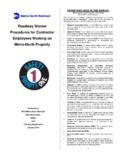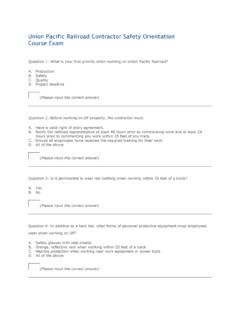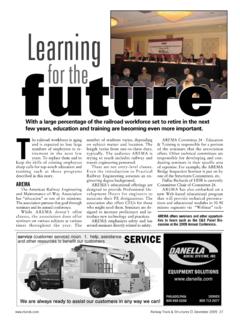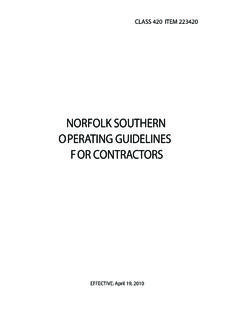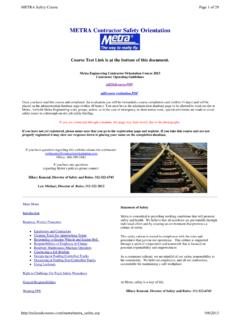Transcription of 1 Roadway Worker Protection - Railroad and …
1 1 roadway worker protection Introduction This course will cover the following: Basic Safety Working On Or Near Tracks Roadway Worker Protection o Definitions o Training o Responsibilities o Employee in charge o Job Briefing o Safety Procedures o Follow-up Job Briefing o Authority o Fouling Track o Working Limits o Types of Protections o Using a Flagman o Right to Challenge Incidents and Injuries Caring for the Injured Inspecting Equipment Next Special thanks to METRA Commuter Railroad for its contributions in content and design with their cooperative contribution with the FRA for this course. 2 Basic Safety Rules Safety Responsibilities These safety rules are basic guidelines to protect your health and safety. These rules cannot cover every possible work situation. You are the only person who can guarantee that you will perform your work safely.
2 Safety Safety is the most important element in performing duties. Obeying the rules is essential to job safety and continued employment. Alert and Attentive Employees must be careful to prevent injuring themselves or others. They must be alert and attentive when performing their duties and plan their work to avoid injury. Accidents, Injuries, and Defects Report by the first means of communication any accidents; personal injuries; defects in tracks, bridges, or signals; or any unusual condition that may affect the safe and efficient operation of the Railroad . Where required, furnish a written report promptly after reporting the incident. Personal Injuries and Accidents Equipment Inspection If an accident results in personal injury or death, all tools, machinery, and other equipment involved, including the accident site, must be inspected promptly by the foreman, another person in charge of the work, or other competent inspectors.
3 The inspector must promptly forward to his manager a report of the inspection. The report must include the condition of the equipment and the names of those making the inspection. If requested by the claims department, the equipment inspected must be marked for identification and placed in custody of the responsible manager or employee. 3 Drugs and Alcohol The use or possession of alcoholic beverages while on duty or on company property is prohibited. Employees must not have any measurable alcohol in their breath or in their bodily fluids when reporting for duty, while on duty, or while on company property. The use or possession of intoxicants, over-the-counter or prescription drugs, narcotics, controlled substances, or medication that may adversely affect safe performance is prohibited while on duty or on company property, except medication that is permitted by a medical practitioner and used as prescribed. Employees must not have any prohibited substances in their bodily fluids when reporting for duty, while on duty, or while on company property.
4 Weapons While on duty or on Railroad property, employees must not have firearms or other deadly weapons, including knives with a blade longer than 3 inches. Employees may possess these weapons only if they are authorized to use them to perform their duties, or if the designated manager gives them special permission. Note: you must be familiar with each specific Railroad that you work on for specific policies regarding Drugs, weapons, and other requirements. 4 Alert to Train Movement Employees must expect the movement of trains, engines, cars, or other movable equipment at any time, on any track, and in either direction. Employees must not stand on the track in front of an approaching engine, car, or other moving equipment. Employees must be aware of location of structures or obstructions where clearances are close. 5 Housekeeping Housekeeping is essential to safety. To provide the safest possible work environment, every employee must actively participate in housekeeping.
5 Disposing of Trash Follow these requirements to dispose of trash properly: Dispose of the following materials daily: Paper Shavings and Sawdust Discarded clothing Greasy or saturated rags or absorbent material Dispose of flammable material in the proper receptacles, not in drawers, lockers, bins, or cupboards. Dispose of pressurized containers properly. Do not litter. To dispose of material that could be environmentally damaging, hazardous, or infectious, see Disposing of Potentially Harmful Material. 6 Job Briefings Job briefings are essential to on-the-job safety. Job briefings are also required by federal regulations (49 CFR Part 214) before employees can perform certain duties. Job briefings are used to inform employees about the tasks to be performed that day. A job briefing is required each time the environment, physical characteristics, or tasks change the working conditions. A job briefing should be performed before the start of work each day.
6 A supervisor of the work to be performed or a qualified employee designated by that supervisor must give the job briefing. Job briefings must include the following: The Rule of the Day Details about what jobs or tasks will be done Explanation of why the jobs or tasks will be done Time frame for accomplishing the jobs or tasks Instructions on how to perform the jobs or tasks List of employees who will perform the jobs or tasks Type of Protection that employees will have along the right-of-way Assessment of the personal protective equipment (PPE) that each employee must have and use 7 Walking Safely Follow these requirements for walking safely in general: Avoid dangerous shortcuts. Protect wet or freshly painted floors with signs, barricades, or ropes. Do not remove the Protection until the floor is safe to walk on. Do not walk through steam or smoke that obscures your vision except in an emergency, and then using extreme caution.
7 Do not cross between standing coupled cars except when necessary to perform your duties Snowy or Icy Surfaces Follow these requirements when walking on a snowy or icy surface: Use caution when walking on snowy or icy surfaces. Avoid walking on ice. If you will be working in snowy or icy conditions, Your Host Railroad may require that you wear ice chains or ice cleats over your footwear. If you have any questions, contact your supervisor. Use caution when wearing ice chains or cleats. Do not wear them: Where they could damage floor coverings When climbing a ladder On concrete, cement, or blacktop that is free of ice and snow Do not walk under icicles. Remove ice and snow buildup from above doorways, walkways, and other places where it could fall and injure someone. Remove snow and ice from areas where employees walk, including: Platforms and Steps Walkways Transfer plates Skids If necessary, apply sand, salt, or other suitable material.
8 For the proper procedures to use when applying these materials, contact your supervisor. 8 Elevated Places, Stairs, Doors, and Elevators Follow these requirements when walking on an elevated place, walking on stairs, using a door, or riding an elevator: When working on engines, cars, scaffolds, or other elevated places: Look before you step in any direction. Avoid losing your balance. Avoid slipping, tripping, or falling over fixed or movable parts, material, or tools. Wear appropriate fall Protection . Keep your hands out of your pockets when you are: Walking on stairs or Walking in a yard Crossing tracks Walking anywhere a stumbling or slipping hazard may exist Do not step on any rail. When walking on stairs, use handrails when possible. Do not run on stairs, in rooms, or in passageways. When coming around a corner, use caution to prevent colliding with persons or vehicles.
9 When opening a door without a window, use caution and open the door slowly. When riding an elevator: Face the door. When entering and leaving, watch your step and the movement of the doors. When entering and leaving, make sure the elevator has stopped at floor level. Standing Do not stand on objects that are not secure. Do not stand or try to stand on unsafe supports, such as boxes, barrels, chairs, stools, or improvised scaffolds. 9 Avoiding Slipping and Tripping Hazards Follow these requirements to avoid slipping and tripping hazards: Do not leave objects where employees can trip over them. If you cannot move an object to a safe place: Barricade or isolate the object until it can be moved. Tell your supervisor promptly. Do not leave clothing, tools, or other objects on ladder rungs, handholds, footboards, running boards, or steps. Do not leave objects where they can be hit by moving equipment or a person on moving equipment.
10 Do not put oil, grease, or other slippery substances on surfaces where employees could slip or lose their hand -hold. Avoid stepping on a surface covered with a substance that could make you slip, slide, or lose your footing. Identify and protect areas where the surface may be slippery until the areas are cleaned. Notify your supervisor of these areas as soon as possible. 10 Proper Clothing To prevent personal injury: Do not wear the following types of clothing: Torn, loose, or baggy clothing Shirts with loose-hanging shirt sleeves Short pants (including cut-offs and walking shorts) Pants with cuffs Nylon or other synthetic clothing when welding, flame cutting, or working around electrical equipment or devices Clothing that will interfere with vision, hearing, or the free use of your hands and feet Eye shields, visors, or other apparel made of highly flammable material Metal safety eyewear, where it could contact a live electrical circuit Clothing with an uncovered metal zipper, when you are required to work with radiant heat or an exposed electrical circuit Do not wear clothing saturated with.
